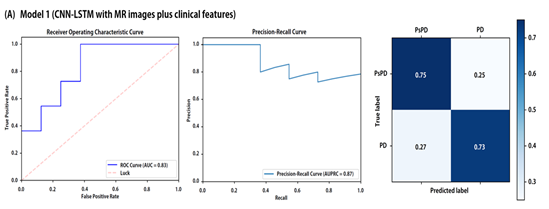글로벌 연구동향
방사선생물학
- 2018년 09월호
[Sci Rep.] Prediction of Pseudoprogression versus Progression using Machine Learning Algorithm in Glioblastoma.서울의대 / 장범섭, 전승혁, 김인아*
- 출처
- Sci Rep.
- 등재일
- 2018 Aug 21
- 저널이슈번호
- 8(1):12516. doi: 10.1038/s41598-018-31007-2.
- 내용

- 딥러닝 기계학습 모델의 모식도: Image 학습능력에 뛰어난 Convolutional Neural Network과 sequence 학습능력에 뛰어난 Long-Short Term Memory 구조를 동시에 사용하고 임상정보는 neural network로 연결하여 brain MR 이미지 상 나타나는 의심병변이 pseudoprogression인지 progression 인지 예측하게 한다.
- 환자의 임상정보와 이미지정보를 같이 학습한 기계학습 모델이 둘 중 한가지만 학습한 경우보다 테스트셋에서 뛰어난 예측력을 보였다.
Abstract
We aimed to investigate the feasibility of machine learning (ML) algorithm to distinguish pseudoprogression (PsPD) from progression (PD) in patients with glioblastoma (GBM). We recruited the patients diagnosed as primary GBM who received gross total resection (GTR) and concurrent chemoradiotherapy in two institutions from April 2010 to April 2017 and presented suspicious contrast-enhanced lesion on brain magnetic resonance imaging (MRI) during follow-up. Patients from two institutions were allocated to training (N = 59) and testing (N = 19) datasets, respectively. We developed a convolutional neural network combined with a long short-term memory ML structure. MRI data, which was 9 axial post-contrast T1-weighted images in our study, and clinical features were incorporated (Model 1). In the testing set, the trained Model 1 resulted in AUC of 0.83, AUPRC of 0.87, and F1-score of 0.74 using optimal threshold. The performance was superior to that of Model 2 (CNN-LSTM model with MRI data alone) and Model 3 (random forest model with clinical feature alone). The developed algorithm involving MRI data and clinical features could help making decision during follow-up of patients with GBM treated with GTR and concurrent CCRT.
Author informationJang BS1, Jeon SH1, Kim IH1,2, Kim IA3,4.
1
Department of Radiation Oncology, Seoul National University Hospital, Seoul, Korea.
2
Institute of Radiation Medicine, Cancer Research Institute, Seoul National University College of Medicine, Seoul, Korea.
3
Department of Radiation Oncology, Seoul National University Bundang Hospital, Seongnamsi, Korea. inah228@snu.ac.kr.
4
Institute of Radiation Medicine, Cancer Research Institute, Seoul National University College of Medicine, Seoul, Korea. inah228@snu.ac.kr.이달의 연구자 바로가기
http://www.rmwebzine.re.kr/newshome/mtnmain.php?mtnkey=articleview&mkey=scatelist&mkey2=76&aid=2826
- 연구소개
- Glioblastoma 환자에게 있어서 표준항암방사선요법 후 brain MRI 상에서 나타나는 병변이 pseudoprogression 혹은 progression을 감별하는 것이 향후 추가치료를 위한 decision-making에 매우 중요한데, 다양한 영상의학적 modality를 동원하여도 감별이 용이치 않은 상황입니다. 본 연구는 서울대병원 및 분당서울대병원에서 Glioblastoma로 표준치료를 받은 환자들의 분자병리학적 소견 및 방사선 치료와 관련된 인자와 함께 T1-Gd-enhaced axial brain MR 이미지를 수집하고, deep learning을 이용한 테스트 및 검증과정을 거쳐 pseudoprogression vs. progression을 감별하는 예측모델을 구축하여 보고한 논문입니다.
- 덧글달기







